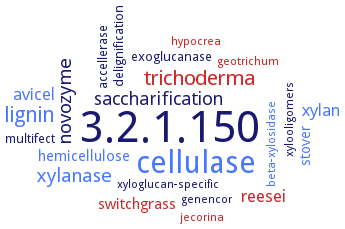3.2.1.150: oligoxyloglucan reducing-end-specific cellobiohydrolase
This is an abbreviated version!
For detailed information about oligoxyloglucan reducing-end-specific cellobiohydrolase, go to the full flat file.

Word Map on EC 3.2.1.150 
-
3.2.1.150
-
cellulase
-
lignin
-
trichoderma
-
novozyme
-
xylanase
-
saccharification
-
reesei
-
xylan
-
avicel
-
hemicellulose
-
switchgrass
-
stover
-
multifect
-
delignification
-
accellerase
-
exoglucanase
-
xyloglucan-specific
-
xylooligomers
-
genencor
-
jecorina
-
beta-xylosidase
-
geotrichum
-
hypocrea
- 3.2.1.150
- cellulase
- lignin
- trichoderma
-
novozyme
- xylanase
-
saccharification
- reesei
- xylan
- avicel
- hemicellulose
- switchgrass
- stover
-
multifect
-
delignification
-
accellerase
- exoglucanase
-
xyloglucan-specific
-
xylooligomers
-
genencor
- jecorina
- beta-xylosidase
- geotrichum
- hypocrea
Reaction
Synonyms
1,4-beta-D-glucan cellobiohydrolase, 1,4-beta-glucan cellobiohydrolase, 1,4-beta-glucan cellobiosidase, avicelase II, beta-1,4-cellobiopyranosidase, beta-1,4-cellobiosidase, beta-1,4-glucan cellobiohydrolase, beta-D-cellobiosidase, C1 cellulase, cellobiohydrolase, cellobiohydrolase I, cellobiohydrolase II, cellobiohydrolase, exo-, cellobiosidase, cellobiosidase, 1,4-beta-glucan, cellulase, C1, cellulose 1,4-beta-cellobiosidase, exo-1,4-beta-D-cellobiohydrolase, exo-beta-1,4-glucan cellobiohydrolase, exocellobiohydrolase, oligoxyloglucan reducing end-specific cellobiohydrolase, oligoxyloglucan reducing-end-specific cellobiohydrolase, OXG-RCBH, spezyme CP


 results (
results ( results (
results ( top
top






